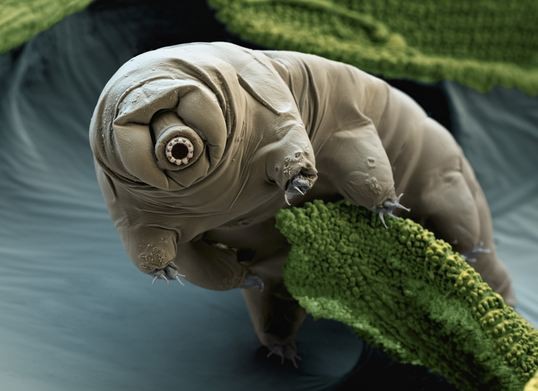"Tardigrades" Found on Hull of the International Space Station
| Arthur Dominic Villasanta | | Sep 01, 2014 11:30 AM EDT |
(Photo : NASA) A scanning electron micrograph of a Tardigrade
It turns out those mysterious "sea plankton" discovered alive on the hull of the International Space Station a few weeks ago are the toughest animals in our known universe.
These creatures might even have seeded the Earth with life. And might have done so in other planets, as well.
Like Us on Facebook
Scientists have now confirmed the extraordinary space organisms on the ISS' hull are "tardigrades."
These microscopic animals are able to survive in sub-zero Arctic ice and in pressures greater than that of the Mariana Trench, the deepest part of the ocean.
Tardigrades are the most incredible example of organisms called "extremophiles."
They're the first known animal to survive in space. unshielded from the airless vacuum of space and from deadly cosmic radiation. It's been proven tardigrades can survive the vacuum of outer space and solar radiation combined for at least 10 days.
This ability was proven by scientists in September 2007. A number of tardigrades were launched into low earth orbit for 10days as part of an astrobiology experiment.
After returning to earth, close to 70 percent of the tardigrades protected from UV radiation were revived within 30 minutes.
Scientists concluded that microgravity and cosmic radiation "did not significantly affect survival of tardigrades in flight, confirming that tardigrades represent a useful animal for space research."
Tardigrades are the most extreme of extremophiles.
Extremophiles are organisms that can survive and thrive in a physically or geochemically extreme condition that would kill most other animals.
Scientists have proven tardigrades can withstand temperatures from almost absolute zero to well above the boiling point of water. Tardigrades are able to survive pressures about six times greater than those found in the deepest ocean trench on Earth.
They can shrug-off ionizing radiation hundreds of times greater than the lethal dose for a human, and can survive the vacuum of outer space.
Incredibly, these animals can go without food or water for more than 10 years. They only need one molecule of water to survive.
Tardigrades are also known as waterbears, They're short, plump water-dwelling, segmented micro-animals with four pairs of legs. Each leg has four to eight claws called "disks." It also has a prominent snout that looks like a tank cannon.
Tardigrades are some 0.5 mm long when fully grown although some can exceed 1 mm in length.
They're prevalent in mosses and lichens. They feed on algae, plant cells and small invertebrates. Scientists have identified over 1,150 tardigrade species.
©2015 Chinatopix All rights reserved. Do not reproduce without permission
EDITOR'S PICKS
-

Did the Trump administration just announce plans for a trade war with ‘hostile’ China and Russia?
-

US Senate passes Taiwan travel bill slammed by China
-

As Yan Sihong’s family grieves, here are other Chinese students who went missing abroad. Some have never been found
-

Beijing blasts Western critics who ‘smear China’ with the term sharp power
-

China Envoy Seeks to Defuse Tensions With U.S. as a Trade War Brews
-

Singapore's Deputy PM Provides Bitcoin Vote of Confidence Amid China's Blanket Bans
-

China warns investors over risks in overseas virtual currency trading
-

Chinese government most trustworthy: survey
-

Kashima Antlers On Course For Back-To-Back Titles
MOST POPULAR
LATEST NEWS
Zhou Yongkang: China's Former Security Chief Sentenced to Life in Prison

China's former Chief of the Ministry of Public Security, Zhou Yongkang, has been given a life sentence after he was found guilty of abusing his office, bribery and deliberately ... Full Article
TRENDING STORY

China Pork Prices Expected to Stabilize As The Supplies Recover

Elephone P9000 Smartphone is now on Sale on Amazon India

There's a Big Chance Cliffhangers Won't Still Be Resolved When Grey's Anatomy Season 13 Returns

Supreme Court Ruled on Samsung vs Apple Dispute for Patent Infringement

Microsoft Surface Pro 5 Rumors and Release Date: What is the Latest?










